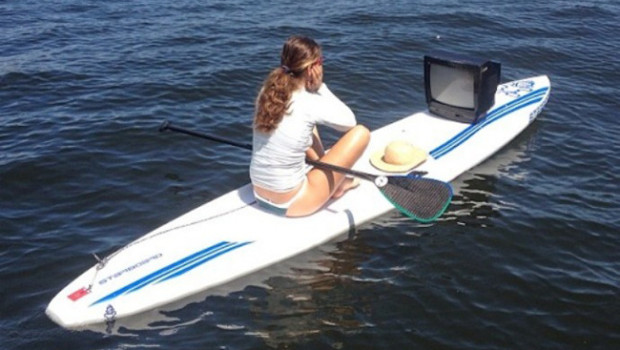2016 Olympics: Adapting to local conditions
Published on May 27th, 2014
The first of two ‘Test Events’ for the Rio 2016 Olympic Sailing Competition will occur on August 2-9, 2014, offering national teams the opportunity to test their training on the venue that will decide the medals. With the heightened focus on pollution at the venue, adapting to local conditions may prove to be a test of tolerance.
Memories of the 2007 Pan Am Games in Rio linger online…
“Our starting line was placed in the middle of a liquid garbage dump. There were plastic grocery bags semi submerged all over the place. There was palm frons. There were leaves. There was a window frame with a screen still installed in it. I’m going to assume the rest of the house must have sunk. This is mildly off-putting, but one of the Hobie-16 sailors reported seeing what was either a dead dog or a dead pig floating somewhere near the port layline.” – Bill Froude, Lightning silver medalist
“The surrounding geography is beyond imagination. Towering rocky peaks, dynamic urban skyline and curvy beach-lined bays dominate the sailing areas. The place is quite beautiful when you take it in at first glance. The only trouble is the widespread poverty and pollution in and around the city and bay. One of the running jokes around the boatpark describes the fact that the slums surrounding the Athlete’s Village and city of Rio are constantly on fire, and the air often smells of something burning. Current lines can be deciphered very easily thanks to plastic bags, dead fish, and more items than I would care to discuss here all falling under the category: trash.” – Andrew Campbell, Laser gold medalist.
Not much has improved in seven years. Last November, it was revealed Guanabara Bay has 78-times Brazil’s legally allowed limit of fecal pollution, and 195-times the US limit.
Two-time Olympic medalist Lars Grael, one of Brazil’s most notable sailors, is not defending the scene. “As teams are coming here, the scenery they encounter is the absolute pollution. There is pollution of floating garbage, and the water quality is repugnant and disgusting. In Guanabara Bay I’ve come across corpses four times. Imagine that … a scene in the Olympics! God grant that this does not happen.”
While Guanabara Bay keeps the sailing events near the Olympic venue, Grael suggests the organizers made a mistake by not moving the course. “The wind in Buzios (180 km to the east), even at the time of August, is excellent, considered one of the best lanes in the world. The wind of Rio de Janeiro in August, unlike Buzios, has a weak and variable prevalence. The second rationale for the boater that is critical is the quality of the water. Buzios water is clear.”
Regarding health concerns, Grael remains hopeful. “I think it will have a certain panic about the risk of infection of disease, but we sailed here often, at all ages, and even swimmers and rowers have no recent record of any contamination that comes from the waters of Guanabara Bay. So, I guess this is more panic.
“The shame is that we have to show the quality of the water. The water was to be clear but is dark brown, smelly. It is a picture of shame over to introduce our dirty house in a beautiful postcard, which could be the big picture of the Olympics, and a tainted landscape. But with regard to contamination by disease I think the chance is minimal. In practice we found no contamination in current users of Guanabara Bay, so I think any specific medication will not be necessary.”








 We’ll keep your information safe.
We’ll keep your information safe.